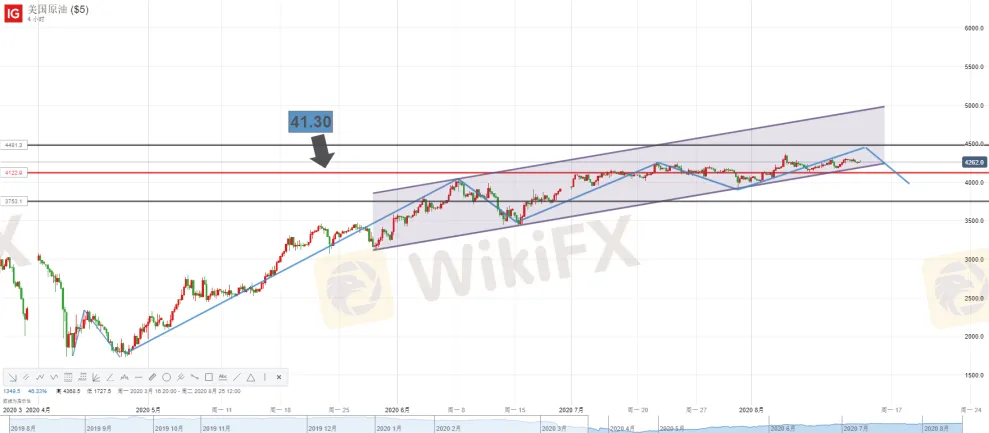简体中文
繁體中文
English
Pусский
日本語
ภาษาไทย
Tiếng Việt
Bahasa Indonesia
Español
हिन्दी
Filippiiniläinen
Français
Deutsch
Português
Türkçe
한국어
العربية
Will Oil Prices Rise on Continuous Positives?
Abstract:WTI crude oil has seen its second consecutive week of gains, while oil prices may get a tailwind from the continuous upbeat news of vaccine and the situation in the Middle East.
WikiFX News (17 Aug)- WTI crude oil has seen its second consecutive week of gains, while oil prices may get a tailwind from the continuous upbeat news of vaccine and the situation in the Middle East.
According to the three reports on crude oil released last week, the outlook of market demand has improved largely compared to early days of the outbreaks. Among them, the Short-Term Energy Outlook of the U.S. Energy Information Administration (EIA) even raised estimates on global demand of crude oil for 2020 by 40,000 b/d.
All eyes turn to OPEC+ Joint Ministerial Monitoring Committee (JMMC) meeting this Wednesday (August 19). OPEC+ is expected to keep the overall production unchanged but fuel oil prices if member countries' compliance with the agreed reduction is proposed again.
Meanwhile, the speculative net long position held in Brent crude oil rose 17,104 to 205,108 lots, according to the data of Intercontinental Exchange (ICE).
Furthermore, as the balanced situation in the Middle East is possible to be upset by the establishment of diplomatic relation between Israel and the UAE, oil prices may soar amid worries about supply once the relation between the U.S. and Iraq deteriorates even further.

All the above is provided by WikiFX, a platform world-renowned for foreign exchange information. For details, please download the WikiFX App: bit.ly/WIKIFX
You can also find us here-
Vietnam: www.facebook.com/wikifx.vn
Thailand: www.facebook.com/wikifx.th
Indonesia: www.facebook.com/wikifx.id
South Asia: www.facebook.com/wikifxglobal
Italy: www.facebook.com/wikifx.it
Japan: www.facebook.com/wikifx.jp
India: www.facebook.com/wikifx.in
Pakistan: www.facebook.com/wikifx.pk
Bangladesh: www.facebook.com/wikifx.bd
Arabian countries: www.facebook.com/wikifx.arab
Russian countries: www.facebook.com/wikifx.russian
French countries: www.facebook.com/wikifx.French
Western Pacific area: www.facebook.com/wikifx.westernpacific
Disclaimer:
The views in this article only represent the author's personal views, and do not constitute investment advice on this platform. This platform does not guarantee the accuracy, completeness and timeliness of the information in the article, and will not be liable for any loss caused by the use of or reliance on the information in the article.
Read more

Oil Prices Drop as OPEC+ Considers Raising Production
Oil prices fell sharply this week as traders worried that OPEC+ might decide to pump more oil into the market at its upcoming meeting.

50% Tariff Imposed on India: The Sectors That Will Be Hit the Hardest
Finally, the day (August 27, 2025) arrived that India did not want. The imposition of 50% tariff by the US administration on most products exported from India. As per the US, the tariff is largely due to India continuing to purchase Russian oil. The extra 25% duty was added over 25% imposed at the beginning of August 2025 as India refused to stop purchasing Russian crude and defence hardware. Check out the sectors that will be hit the hardest with this tariff increase.

GemForex | Crude Oil (WTI)
Crude Oil (WTI) - Rebound in the offing?

Oil inches higher as OPEC meetings continue
A stronger than expected payroll report last Friday pushed equity markets to another all-time high. The U.S. economy added 850,000 new jobs during June when the consensus expected 700,000. Whilst the headline number looks good, there’s plenty to be worried about under the hood, as the new jobs are mostly in those sectors of the economy that have reopened. For instance, the leisure and hospitality sectors added 343,000 new jobs, education around 269,000, and the retail sector 67,000. These add up to around 80% of the total; this is great at first glance but not in the long run since these sectors do not drive the productivity or wage growth required for sustainable expansion. In particular, the U.S. economy is 70% consumer driven, which emphasizes the importance of a healthy and wealthy labor market. With the country still 7 million jobs short of pre-pandemic levels and most of the recovery happening in low-paying and low-productivity sectors, there is still a long way to go before the
WikiFX Broker
Latest News
Angel one 2025 Review & Complaints
Latest FCA Daily Alerts and Consumer Warnings for 2025
Webull Widens Crypto Futures with Coinbase Derivatives
Is Nash Markets Regulated or Risk? Truth About Nash Markets’ License & Withdrawal Issues
CySEC Blocks Certification Access to Combat Advisor Impersonation
Exclusive Markets Under the Scanner: Traders Report High Swap Charges, Deposit Discrepancies & More
The United States Outgrows All Its Major Peers
PINAKINE Broker India Review 2025: A Complete Guide to Safety and Services
Pinched By Penny Shortage, US Retailers Beg Congress To Step In
PINAKINE Broker Review: A Complete Look at Its Services and Risks
Currency Calculator




